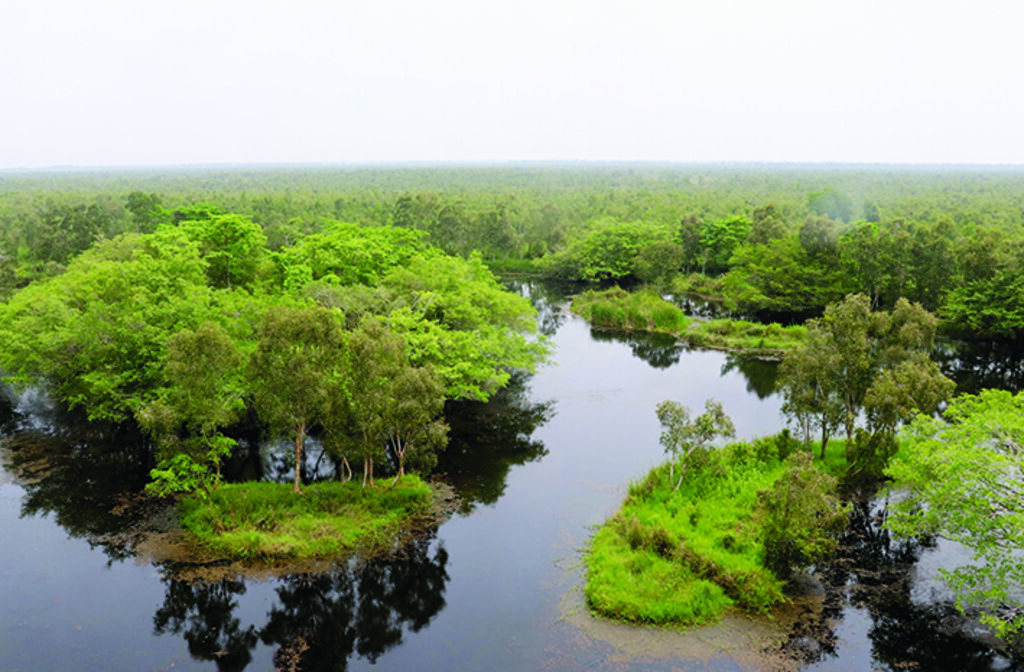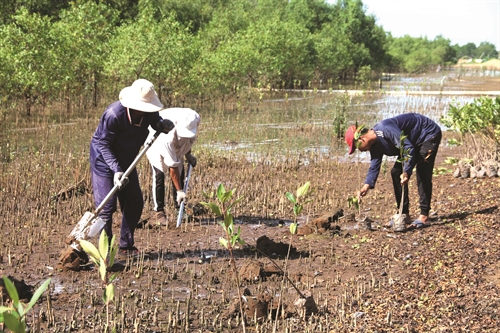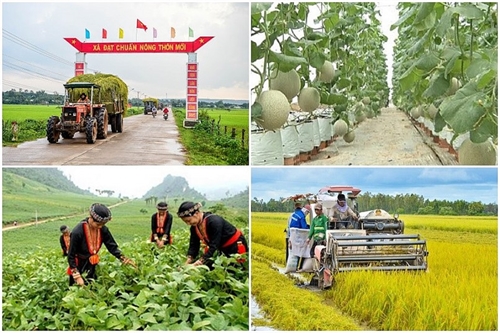Vu Van Anh
 |
| U Minh Thuong National Park, Kien Giang province__Photo: Le Huy Hai/VNA |
Vietnam’s accession to the Ramsar Convention
The Convention on Wetlands of International Importance, especially as Waterfowl Habitat, was signed in Ramsar (Iran) on February 2, 1971. It is a frame convention and constitutes a basis for the member states to carry out activities and international cooperation in the conservation and wise use of wetlands and their resources. It also aims to provide a framework for national plans of action and international cooperation for the conservation and wise use of wetlands and their resources.
The Ramsar Convention is tasked with the mission to “conserve and wisely use wetlands smartly through local, regional and national actions and international cooperation with a view to contributing to achieving the goal of global sustainable development” with the participation of 172 member states.
At present, Vietnam possesses over 12 million hectares of wetlands spreading widely throughout various ecological areas, including many wetlands determined as having high conservatory value (lying in nature reserves and many of which have been recognized as Ramsar sites), providing essential ecological services for socio-economic development and environmental protection. According to statistics, the wetlands have supplied food and aquatic resources for domestic consumption and export valued at over USD 10 billion in 2017 alone. About 20 million people in Vietnam have earned principal or partial incomes from aquatic resources and have been exploiting and using more than 300 marine species and over 50 fresh-water species of high economic value.[1]
Fully aware of the importance of wetlands, Vietnam acceded to the Ramsar Convention in 1989, becoming the 50th contracting parties and the first Southeast Asian nation joining this Convention. By ratifying the Ramsar Convention, the Government has committed to establishing a typical Ramsar site system. On September 23, 2003, the Government issued Decree 109/2003/ND-CP on conservation and sustainable development of wetlands.
In January 1989, Xuan Thuy national park (Nam Dinh province) was recognized as the first Ramsar site of Vietnam upon its official accession to the Ramsar Convention and the 50th Ramsar site of the world. The national park covers around 7,100 ha, including 3,100 ha of alluvial forests and 4,000 ha of mangrove forests. This is a nature reserve with many distinctive habitats of the wetland ecological system with numerous wild animals and plants as well as rare and specious migratory birds. In December 2004, UNESCO recognized Xuan Thuy national park as the core zone of the world nature reserve along the coast of the Red River delta.
Since then, nine more Ramsar sites have been recognized in Vietnam. This has contributed to attracting the international and national attention to the conservation of wetlands while intensifying the conservation of priceless sources for natural and humanity tourism of the country in general and the Ramsar sites in particular, thereby helping attract domestic and foreign visitors and contributing to the socio-economic development.
Implementation of the Ramsar Convention in Vietnam
Translation of the Ramsar Convention’s provisions into domestic regulations and improvement of legal documents on management of wetlands
Vietnam has been formulating and improving its legal system in adherence to the principles and compliance with the provisions of the Ramsar Convention, including the Government’s Decree 109/2003/ND-CP dated September 23, 2003, on the conservation and sustainable development of wetlands. It can be said that this is the first legal document directly providing the management of wetlands for the implementation of the Ramsar Convention. This Decree’s provisions have been concretized into strategies, policies and plans of action of the natural resources and environment sector and related ministries, ministerial-level agencies and localities nationwide.
So far, Vietnam has enacted four laws concerning the management of wetlands, including the 2003 Law on Aquatic Resources (as revised in 2017); the 2004 Law on Forest Protection and Development (superseded by the 2017 Forestry Law); the 2005 Law on Environmental Protection (as revised in 2014 and 2020); and 2008 the Law on Bio-Diversity, and a number of guiding legal texts. The 2008 Law on Bio-Diversity is the first legal document of Vietnam’s legal system using the term of wetlands. Its Article 35 on sustainable development of natural eco-systems in natural wetlands directly regulates wetlands and inventory and establishment of the sustainable development regime of natural Ramsar sites in Vietnam. On that basis, the wetland classification system has been promulgated with 26 types of wetlands divided into three groups of marine and coastal wetlands, inland wetlands and artificial wetlands.
The 2020 Law on Environmental Protection adds new provisions on important wetlands and wetland eco-system services for tourist, leisure and aquaculture purposes. The environment-sensitive factors used for the classification of investment projects include important wetlands and environmental information including information on important wetlands. Besides, the wetland eco-system services for tourist, leisure and aquaculture purposes constitute a type of paid natural eco-system services.
In order to meet requirements of the management of Vietnamese wetlands in face of development pressure and global climate change trends and in the context that the Law on Biodiversity has been enacted, the Vietnamese Government promulgated Decree 66/2019/ND-CP dated July 29, 2019, on conservation and sustainable use of wetlands in replacement of Decree 109/2003/ND-CP dated September 23, 2003, translating the requirements of the Ramsar Convention into domestic regulations and comprehensively providing specific policies on management of wetlands, wetland reserves, Ramsar sites, important wetlands, and activities of promotion of, and investment of resources in, the conservation and sustainable use of wetlands in Vietnam. Decree 66/2019/ND-CP consists of five chapters with 33 articles and applies to domestic organizations, households and individuals, overseas Vietnamese, foreign organizations and individuals directly engaged in or related to the conservation and use of wetlands in the Vietnamese territory.
In addition, wetlands have been referred to in many legal documents such as Government Resolution 06/NQ-CP dated January 21, 2021, promulgating the Program of Action to continue the implementation of Resolution 24-NQ/TW of the 11th Party Central Committee on active response to climate change, enhanced management of resources and environmental protection under the Political Bureau’s Conclusion 56-KL/TW dated August 23, 2019; the Ministry of Natural Resources and Environment’s Circular 07/2020/TT-BTNMT dated August 31, 2020, detailing the provisions of Article 31.1.c of Decree 66/2019/ND-CP, and Circular 27/2018/TT-BTNMT dated December 14, 2018, providing the making of statistics on and inventory of land and making of land use status maps with monthly inventory forms; the Prime Minister’s Directive 15/CT-TTg dated June 17, 2019, on land inventory and making of land use status maps for 2019, including wetland inventory contents; the Prime Minister’s Decision 1932/QD-TTg dated December 30, 2019, approving the Scheme on inventory of land and making of land use status maps for 2019, including wetland inventory; and the Ministry of Natural Resources and Environment’s Circular 07/2020/TT-BTNMT dated August 31, 2020, detailing the provisions of Article 31.1.c of Government Decree 66/2019/ND-CP.
Lately, the Prime Minister issued on November 24, 2021, Decision 1975/QD-TTg, promulgating the National Plan of Action to conserve and sustainably use wetlands in the 2021-30 period. This Decision sets objectives thru 2025 and 2030, specifically:
By 2025:
- There will be 13 wetlands recognized as Ramsar sites;
- The survey of, making of statistics on, and inventory of, wetlands nationwide will be completed.
- Important wetlands and important wetlands showing signs of degeneration will be established, and the database on important wetlands will be developed.
By 2030:
- There will be 15 wetlands recognized as Ramsar sites;
- At least 25 percent of degenerated important wetlands will be restored;
- The land use repurposing and development of eco-tourism and environmentally friendly tourism activities and programs in important wetlands nationwide will be effectively controlled;
- Ecosystem service charges for important wetlands will be paid in wetland reserves and Ramsar sites;
- The capacity and facilities and equipment for organizations and individuals engaged in the conservation and sustainable use of important wetlands will be improved.
In 2023, the Minister of Natural Resources and Environment will set up and organize the operation of the network of Ramsar sites and decide on the list of important wetlands. Together with the National Plan of Action, the aforesaid legal documents will contribute to guiding the implementation of Decree 66/2019/ND-CP, thereby incrementally demonstrating Vietnam’s responsibility as a contracting party to the Ramsar Convention.
Intensification of the management, conservation and wise use of wetlands
To date, Vietnam has planned and zoned off 47 wetland reserves to be established in many regions nationwide with different models of wise use of wetlands by the community’s participation. During the 2019-20 period, Vietnam established two wetland nature reserves in accordance with the Law on Bio-Diversity (Thai Thuy wetland reserve in Thai Binh province, on September 6, 2019, and Tam Giang- Cau Hai wetland reserve in Thua Thien-Hue province on February 20, 2020).
In order to effectively implement the policies and laws on the protection and sustainable development of wetlands, Vietnam and many countries in the world have strictly adhered to three fundamental principles: (i) approaching bio-systems, ensuring the complete preservation of structure, functions, eco-features and bio-diversity of wetlands; (ii) promoting the role and participation of communities living on or around wetlands and stakeholders in the conservation and sustainable use of wetlands; and (iii) ensuring the mechanism for sharing of equal benefits and reasonable rights and obligations among stakeholders in the use of wetland eco-system services.
In furtherance of these principles, the Government has promulgated numerous mechanisms and policies to promote and support the development of new and alternative livelihoods for local people; adopted policies to migrate people from core areas of wetland reserves, and set orientations for development of eco-tourism and animal husbandry in buffer zones in order to help local people get rid of poverty, thereby developing a number of community-based wetland conservation and management models, such as the model of environmentally friendly aquaculture and ecological shrimp ponds along the northern coast; the model of mangrove forest management in Dong Rui commune, Tien Yen district, Quang Ninh province; the model of protection of nipa palm forests in Cam Thanh (Quang Nam province); the model of co-management and genetic resource sharing in the national parks and Ramsar sites in Xuan Thuy (Nam Dinh province) and Tram Chim (Dong Thap province); and the model of co-management of U Minh Ha national park by permitting local people to grow fruit trees around the park while bearing the responsibility to protect the eco-systems in the park, thus contributing to preserving bio-diversity values therein.
So far, many localities have actively formulated projects on compilation of dossiers for establishment of reserves, identifying criteria and possibility for Ramsar sites to be recommended for establishment in the future such as Dong Rui and Tien Yen (Quang Ninh province), Can Gio ( Ho Chi Minh City) Dong Nai nature and culture reserve (Dong Nai province). Meanwhile, the Ministry of Natural Resources and Environment has built a website on the network of Vietnamese Ramsar sites at the address https://vran.vn.
Intensification of international cooperation on conservation and wise use of wetlands
Over the recent years, Vietnam has mobilized active assistance of many international organizations, bilateral and multilateral international partners for the conservation and sustainable use of wetlands.
At the 14th Conference of the Ramsar Convention at the end of 2022, the contracting parties unanimously adopted the Resolutions and committed to conserving and smartly using the wetlands in face of development pressure and global climate change. This serves as a basis for promoting the conservation and bringing into fully play of important values of wetlands in the common efforts to respond to global climate change, and promote green transformation and sustainable development, in response to the appeal of the UN General Assembly on the Decade of “Eco-system Rehabilitation” (the 2021-30 period). Within the framework of this conference, the Vietnamese delegation participated in many official and lobby events with a view to learning and exchanging knowledge about and experience in the wetland management and conservation and the mobilization of international resources in support of the conservation and smart use of wetlands in Vietnam.
Difficulties arising from and solutions for the implementation of the Ramsar Convention
Apart from achievements, Vietnam is facing the following difficulties in the implementation of the Ramsar Convention:
- Impacts of the climate change causing saline intrusion affecting biodiversity and livelihood of the people;
- Harmonious (balanced) settlement of the relationship between the conservation and economic development in wetlands in face of the socio-economic development pressure, especially in coastal and inland wetlands;
- Limited financial capability for investment in nature reserves and sustainable development in Ramsar sites;
- Limited human resources (both quantitatively and qualitatively) for the nature management and conservation in Ramsar sites; and,
- Environmental pollution (caused by water sources and plastic wastes) in Ramsar sites.
In order to tackle the above difficulties and help achieve the objectives of conservation and sustainable use of biodiversity and wetland eco-system services, thus contributing to the sustainable socio-economic development, response to climate change, environmental protection, nature conservation and fulfillment of Vietnam’s obligations as a Ramsar Convention contracting party, the Prime Minister issued on November 24, 2021 Decision 1975/QD-TTg, providing the following six groups of solutions:
- Improvement of policies and legal documents on the management of wetlands;
- Raising of operational efficiency of wetland management organizations;
- Diversification of resources for the conservation and sustainable use of wetlands;
- Intensification of public communication, dissemination for better awareness about and intensified implementation of the law on conservation and sustainable use of wetland resources;
- Promotion of research into conservation and sustainable use of wetland resources; and,
- Intensification of international cooperation on conservation and sustainable use of wetlands.-
| Nine Ramsar sites recognized in Vietnam | |
| 1 | Xuan Thuy national park (Nam Dinh province) was recognized in 1989 as the 50th Ramsar site of the world and the first in Vietnam. Its total area is around 7,100 ha, including 3,100 ha of alluvial forests and 4,000 ha of mangrove forests. This is a nature reserve with many distinctive habitats of the wetland eco-system with many wild animal and plant species and precious and rare migratory fowls. |
| 2 | Bau Sau wetland of Cat Tien national park (Dong Nai province) was recognized in 2005 as the 1,499th Ramsar site of the world and the second in Vietnam. It covers 13,759 ha of wetlands, including 151 ha of year-round wetlands, 5,360 ha of seasonal wetlands and wetland areas which are 115 m below the sea level. |
| 3 | Ba Be national park (Bac Kan province) was recognized in 2011 as the 1,938th Ramsar site of the world and the third of Vietnam. It covers a total area of 44,750 ha, including 10,048 ha of the core area and 34,702 ha of the buffer zone. The core area includes the strictly protected sub-zone of 3,931 ha, the ecological rehabilitation sub-zone of 6,083 ha, and the service and administrative sub-zone of 34 ha. |
| 4 | Tram Chim national park (Dong Thap province) became the 2,000th Ramsar site of the world and the fourth of Vietnam in 2012. It covers nearly 7,500 ha, being one of the eight most important fowl reserves in Vietnam for some 200 bird species (accounting for one fourth of total bird species in Vietnam) with over 20,000 individuals, including red-headed cranes. |
| 5 | Cape Ca Mau national park (Ca Mau province) was recognized in 2013 as the 2,088th Ramsar site of the world and the fifth of Vietnam, covering a total area of 41,862 ha, including 15,262 ha of mainland and 26,000 ha of coastal land. |
| 6 | Con Dao national park (Ba Ria-Vung Tau province) was recognized in 2014 as the 2,203rd Ramsar site of the world and the sixth of Vietnam. It is located in Con Dao island district on a total land area of around 20,000 ha, including nearly 6,000 ha of forest conservation areas, and nearly 14,000 ha of marine conservation areas, in addition to its marine buffer zone of 20,500 ha around the sub-zones. |
| 7 | Lang Sen wetland reserve (Long An province) in 2015 became the 2,227th Ramsar site of the world and the seventh of Vietnam, on a total area of 5.030 ha. |
| 8 | U Minh Thuong national park (Kien Giang province) was recognized in 2016 as the 2,228th Ramsar site of the world and the eighth of Vietnam. It consists of the core area of the U Minh Thuong national park with an area of 8,038 ha. |
| 9 | Van Long wetland nature reserve (Ninh Binh province) was recognized in 2018 as the 2,360th Ramsar site of the world and the 9th of Vietnam. It covers a total area of 2,736 ha, accommodating 39 precious and rare wild animal and plant species recorded in Vietnam’s red book. |
[1] https://baotainguyenmoitruong.vn/bao-ton-va-su-dung-ben-vung-cac-vung-dat-ngap-nuoc-298871.html.









